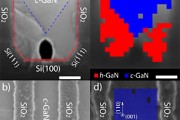 2019-12-03
2019-12-03
Kubos Semiconductors from the UK and the UK Compound Semiconductor Centre (CSC) announced that their partnership to commercialize cubic GaN epitaxy for the manufacture of high efficiency green and amber LEDs. Hexagonal GaN crystals have been widely used to fabricate blue LEDs, but achieving efficient operation in green devices is a problem. Large polarization fields in the active regions of these longer-wavelength structures reduce radiative recombination rates and limit LED efficiency. Targeting the issue, Kubos Semiconductors develops process based on gr...
Continue reading →
 2017-12-05
2017-12-05
Apple is working with Stanford Medicine researchers on a research study to determine whether the Apple Watch’s heart-rate sensor can identify irregular heart rhythms associated with a condition known as atrial fibrillation (AFib).
Continue reading →
 2016-09-22
2016-09-22
The new versions of the PointLED and Firefly LEDs are Osram Opto Semiconductors’ latest additions to its portfolio for use in mobile applications such as fitness tracking and health monitoring. Osram can therefore offer its customers a greater selection of products – to supplement its integrated sensors. Thanks to their greater brightness, the PointLEDs in true green offer better performance and provide better signals than comparable solutions on the market. The Firefly E 1608 in hyper red has a special narrow-band wavelength range around 660 nm so it also offers optimized signal recognition. It is suitable for measuring oxygen levels in blood, while the true green version is ideal for use in pulse monitors. Both color versions of the Firefly have the advantage of compact dimensions, giving customers greater flexibility in designing their products.
Continue reading →
 2016-08-01
2016-08-01
Researchers at the University of Illinois at Urbana Champaign have developed a new method for making brighter and more efficient green light-emitting diodes (LEDs). Using an industry-standard semiconductor growth technique, they have created gallium nitride (GaN) cubic crystals grown on a silicon substrate that are capable of producing powerful green light for advanced solid-state lighting.
Continue reading →
 2016-03-24
2016-03-24
Illuminating fishing nets is a cost-effective means of dramatically reducing the number of sea turtles getting caught and dying unnecessarily, conservation biologists at the University of Exeter have found.
Continue reading →
 2013-12-12
2013-12-12
You might not know what "lattice-matched heterojunctions" are, but if you stopped at a new stoplight, played a DVD or used a laser pointer, you've made use of technology pioneered by Jerry Woodall, distinguished professor of electrical and computer engineering at the University of California, Davis. Woodall's work, begun in the 1960s at IBM Research, is the basis for cheap, energy-efficient light-emitting diodes, or LEDs, and lasers.
Continue reading →
 2012-11-02
2012-11-02
NGK Insulators, Ltd. of Japan has announced the development of high-quality GaN wafers to reduce defects and roughly double the luminous efficiency of green LEDs over previous models. NGK achieved this breakthrough by using a crystal growth technology that it has improved through a proprietary approach. The GaN wafers developed by NGK feature low defect density across the entire 2-inch diameter of the wafer surface and have a colorless transparency. NGK achieved this through proprietary improvements to liquid phase epitaxial technology for single crystal growth. ...
Continue reading →
2012-09-03
Canadian firm Meaglow has made a breakthrough on a low temperature Migration Enhanced Afterglow film growth technique to produce a thick InGaN layer with strong yellow emission, for increasing the efficiency and lowering production costs of green LEDs and laser diodes. It is looking for collaboration opportunities to enhance the material properties required by industry for lighting, display, medical, and military applications and other uses. Meaglow's Chief Scientist K. Scott Butcher, says, "It's the brightest p-n junction I've ever seen in my life,...
Continue reading →
 2019-12-03
2019-12-03
 2017-12-05
2017-12-05
 2016-09-22
2016-09-22
 2016-08-01
2016-08-01
 2016-03-24
2016-03-24
 2013-12-12
2013-12-12
 2012-11-02
2012-11-02